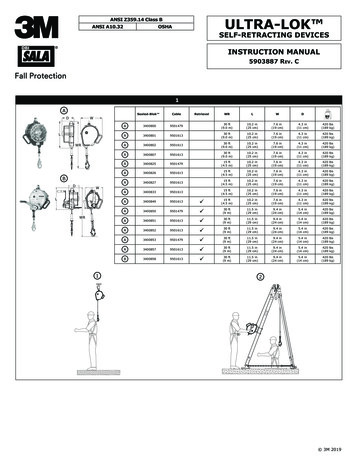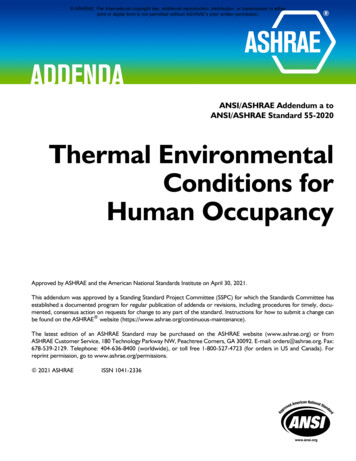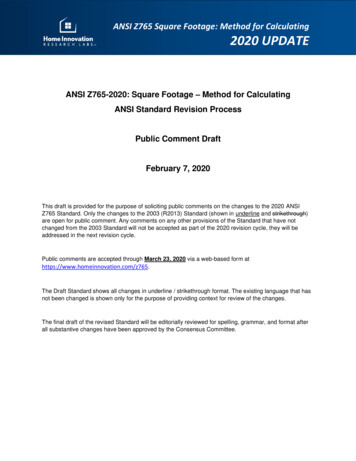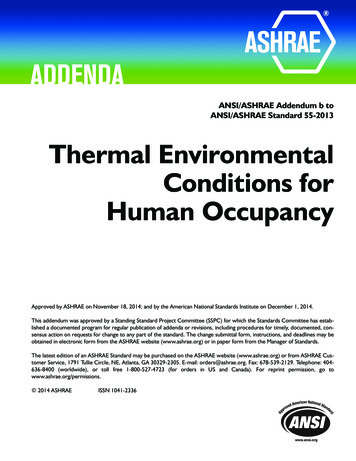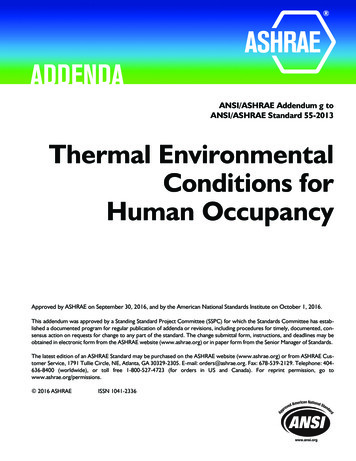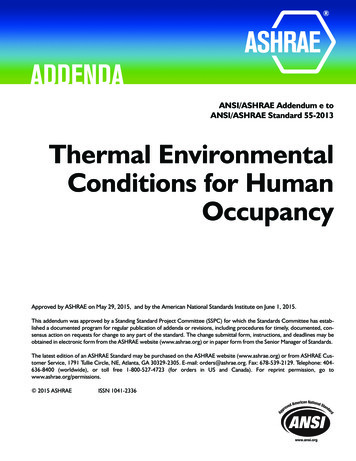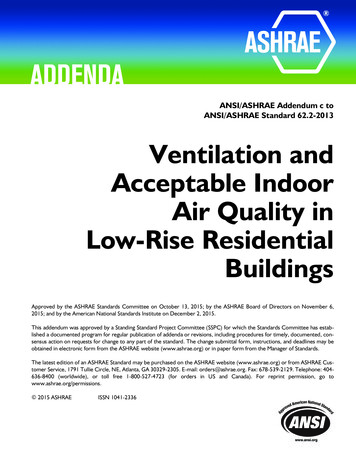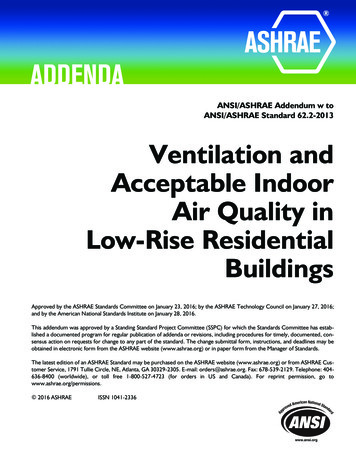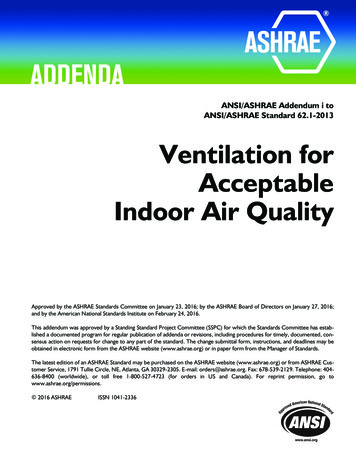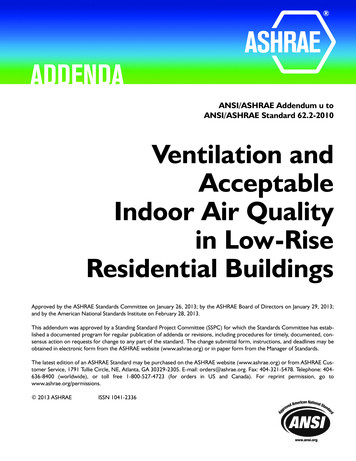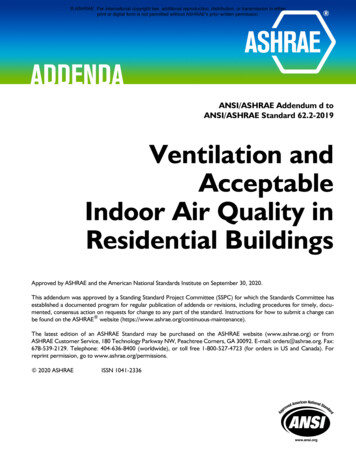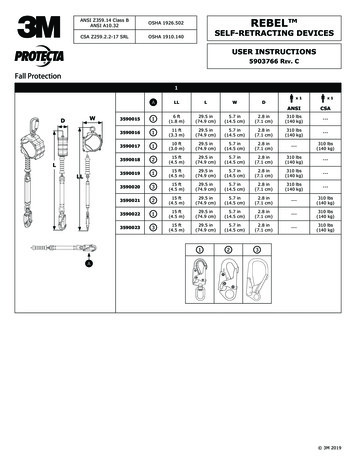
Transcription
ANSI Z359.14 Class BANSI A10.32OSHA 1926.502CSA Z259.2.2-17 SRLOSHA 1910.140Rebel Self-Retracting DeviceSUSER INSTRUCTIONS5903766 Rev. C1WDLLL x1 x1ALLLWDANSICSA359001516 ft(1.8 m)29.5 in(74.9 cm)5.7 in(14.5 cm)2.8 in(7.1 cm)310 lbs(140 kg)---3590016111 ft(3.3 m)29.5 in(74.9 cm)5.7 in(14.5 cm)2.8 in(7.1 cm)310 lbs(140 kg)---3590017110 ft(3.0 m)29.5 in(74.9 cm)5.7 in(14.5 cm)2.8 in(7.1 cm)---310 lbs(140 kg)3590018215 ft(4.5 m)29.5 in(74.9 cm)5.7 in(14.5 cm)2.8 in(7.1 cm)310 lbs(140 kg)---3590019115 ft(4.5 m)29.5 in(74.9 cm)5.7 in(14.5 cm)2.8 in(7.1 cm)310 lbs(140 kg)---3590020315 ft(4.5 m)29.5 in(74.9 cm)5.7 in(14.5 cm)2.8 in(7.1 cm)310 lbs(140 kg)---3590021215 ft(4.5 m)29.5 in(74.9 cm)5.7 in(14.5 cm)2.8 in(7.1 cm)---310 lbs(140 kg)3590022115 ft(4.5 m)29.5 in(74.9 cm)5.7 in(14.5 cm)2.8 in(7.1 cm)---310 lbs(140 kg)3590023315 ft(4.5 m)29.5 in(74.9 cm)5.7 in(14.5 cm)2.8 in(7.1 cm)---310 lbs(140 kg)123A 3M 2019
2DCBAFGE3ABC4C6 ft(1.8 m)210 ft(3.0 m)
4B 6 ft(1.8 m)AA6 ft(1.8 m)7 ft(2.1 m)8 ft(2.4 m) 9 ft(2.7 m)5 ft(1.5 m)0 ft(0 m)2.0 ft(0.61 m)2.0 ft(0.61 m)2.0 ft(0.61 m)15 ft(4.6 m)0 ft(0 m)4.0 ft(1.22 m)6.0 ft(1.83 m)8.0 ft(2.44 m)20 ft(6.1 m)0 ft(0 m)6.0 ft(1.83 m)8.0 ft(2.44 m)12.0 ft(3.66 m)CCB56A.B.E.ABC.D.F.G.C78ABADABCBB3A
910B1112AA13AüBCûBEFCDA14AABB4
SIT 5908239 Rev. CSAFETY INFORMATIONENPlease read, understand, and follow all safety information contained in these instructions prior to the use of this Self-RetractingDevice (SRD). FAILURE TO DO SO COULD RESULT IN SERIOUS INJURY OR DEATH.These instructions must be provided to the user of this equipment. Retain these instructions for future reference.Intended Use:This Self-Retracting Device is intended for use as part of a complete personal fall protection system.Use in any other application including, but not limited to, material handling, recreational or sports related activities, or other activities notdescribed in the User Instructions, is not approved by 3M and could result in serious injury or death.This device is only to be used by trained users in workplace applications.!!WARNINGThis Self-Retracting Device is part of a personal fall protection system. It is expected that all users be fully trained in the safe installation andoperation of their personal fall protection system. Misuse of this device could result in serious injury or death. For proper selection,operation, installation, maintenance, and service, refer to these User Instructions including all manufacturer recommendations, see yoursupervisor, or contact 3M Technical Services. To reduce the risks associated with working with an SRD which, if not avoided, could result in serious injury or death:------------ Before each use, inspect the SRD and check for proper locking and retraction.If inspection reveals an unsafe or defective condition, remove the device from service and repair or replace according to the UserInstructions.If the SRD has been subjected to fall arrest or impact force, immediately remove the SRD from service and label the device ‘UNUSABLE’.Ensure the lifeline is kept free from any and all obstructions including, but not limited to; entanglement with moving machinery orequipment (e.g., the top drive of oil rigs), other workers, yourself, surrounding objects, or impact from overhead objects that could fallonto the lifeline or the worker.Never allow slack in the lifeline. Do not tie or knot the lifeline.Attach the unused leg(s) of the Harness Mounted SRD to the parking attachment(s) of the harness if equipped.Do not use in applications that have an obstructed fall path. Working on slowly shifting material, such as sand or grain, or within confinedor cramped spaces, may not allow the worker to reach sufficient speed to cause the SRD to lock. A clear path is required to assurepositive locking of the SRD.Avoid sudden or quick movements during normal work operation. This may cause the device to lock up.Ensure that fall protection systems/subsystems assembled from components made by different manufacturers are compatible and meetthe requirements of applicable standards, including the ANSI Z359 or other applicable fall protection codes, standards, or requirements.Always consult a Competent and/or Qualified Person before using these systems.To reduce the risks associated with working at height which, if not avoided, could result in serious injury or death:-------------------Ensure your health and physical condition allow you to safely withstand all of the forces associated with working at height. Consult withyour doctor if you have any questions regarding your ability to use this equipment.Never exceed allowable capacity of your fall protection equipment.Never exceed maximum free fall distance of your fall protection equipment.Do not use any fall protection equipment that fails pre-use or other scheduled inspections, or if you have concerns about the use orsuitability of the equipment for your application. Contact 3M Technical Services with any questions.Some subsystem and component combinations may interfere with the operation of this equipment. Only use compatible connections.Consult 3M prior to using this equipment in combination with components or subsystems other than those described in the UserInstructions.Use extra precautions when working around moving machinery (e.g. top drive of oil rigs) electrical hazards, extreme temperatures,chemical hazards, explosive or toxic gases, sharp edges, or below overhead materials that could fall onto you or your fall protectionequipment.Use Arc Flash or Hot Works devices when working in high heat environments.Avoid surfaces and objects that can damage the user or equipment.Ensure there is adequate fall clearance when working at height.Never modify or alter your fall protection equipment. Only 3M or parties authorized in writing by 3M may make repairs to the equipment.Prior to use of fall protection equipment, ensure a rescue plan is in place which allows for prompt rescue if a fall incident occurs.If a fall incident occurs, immediately seek medical attention for the worker who has fallen.Do not use a body belt for fall arrest applications. Use only a Full Body Harness.Minimize swing falls by working as directly below the anchorage point as possible.If training with this device, a secondary fall protection system must be utilized in a manner that does not expose the trainee to anunintended fall hazard.Always wear appropriate personal protective equipment when installing, using, or inspecting the device/system.5
;;Before using this equipment, record the product identification information from the ID label in the ‘Inspection andMaintenance Log’ at the back of this manual.DESCRIPTION:3M Protecta Rebel Self-Retracting Devices (SRDs) are designed for overhead applications where the SRD is mounted aboveand the lifeline remains vertical during use.Figure 2 identifies key components of the Rebel Self-Retracting Devices (SRDs). Rebel SRDs are drum-wound Wire Rope Lifelines(A) which retract into a thermoplastic Housing (B). They can hang from anchorage by a Carabiner (D) attached through theSwivel Eye (C) on the top of the SRD. A Self-Locking Snap Hook (E) on the end of the Lifeline attaches to the designated FallArrest connection on a Full Body Harness. A Bumper (F), protects the Wire Rope and Ferrules securing the Snap Hook fromabrasion and corrosion. The Energy Absorber (G) surrounds an additional reserve lifeline that absorbs energy during a fall.Table 1 – SpecificationsComponent Specifications:SRD HousingsThermoplasticDrumAluminumInternal ComponentsStainless Steel, Zinc Plated Steel and AluminumSwivelZinc Plated SteelLifelineGalvanized steel; 3/16 in (4.76 mm) diameterTensile Strength - 4,200 lbs (18.7 kN)Connector Specifications:Figure Gate OpeningGate StrengthSwivel Self-Locking Snap HookZinc Plated Steel3/4 in (19 mm)3,600 lbs (16 kN)2000161Self-Locking Snap HookZinc Plated Steel3/4 in (19 mm)3,600 lbs (16 kN)2000118Rebar Snap HookZinc Plated Steel2 1/4 in (57 mm)3,600 lbs (16 kN);;Tensile Strength: The tensile strength of each of the connectors listed above is 5,000 lbs (22.2 kN).Figure aterialGate OpeningGate StrengthZinc Plated Steel11/16 in (47 mm)3,600 lbs (16 kN);;Tensile Strength: The tensile strength of each of the connectors listed above is 5,000 lbs (22.2 kN).Performance Specifications:SRL Specifications (Z359.14 Class B)Capacity RangeANSI ModelsCSA Models75 lbs - 310 lbs (34 kg - 140 kg)75 lbs - 310 lbs (34 kg - 140 kg)1,350 lbs (6 kN)1,350 lbs (6 kN)Maximum Arresting ForceAverage Arresting Force900 lbs (4 kN)---Arrest Distance42 in (1.07 m)42 in (1.07 m)Minimum Fall Clearance Required16.0 ft (1.83 m)6.0 ft (1.83 m)2.0 ft (0.6 m)0 ft (0 m)Maximum Free Fall21 - Assumes the SRD is mounted directly above (overhead) the end user.2 - SRD must be mounted above user D-ring.6
1.0 APPLICATIONS1.1PURPOSE: Self-Retracting Devices (SRDs) are designed to be a component in a personal fall arrest system (PFAS). Figure1 illustrates SRDs covered by this instruction manual. They may be used in most situations where a combination of workermobility and fall protection is required (i.e. inspection work, general construction, maintenance work, oil production,confined space work, etc.).1.2STANDARDS: Your SRD conforms to the national or regional standard(s) identified on the front cover of theseinstructions. Refer to the local, state, and federal (OSHA) requirements governing occupational safety for additionalinformation regarding Personal Fall Protection.1.3TRAINING: This equipment is intended to be used by persons trained in its correct application and use. It is the responsibility of theuser to assure they are familiar with these instructions and are trained in the correct care and use of this equipment. Users must alsobe aware of the operating characteristics, application limits, and the consequences of improper use.1.4LIMITATIONS: Always consider the following limitations when installing or using this equipment: Capacity: SRDs are for use by one person with a combined weight (clothing, tools, etc.) meeting the Capacity Rangespecified in Table 1 for your standard(s). Make sure all of the components in your system are rated to a capacityappropriate to your application. Anchorage: Anchorages selected for fall arrest systems shall have a strength capable of sustaining static loadsapplied in the directions permitted by the system of at least:1.2.5,000 lbs. (22.2 kN) for non-certified anchorages, orTwo times the maximum arresting force for certified anchorages.When more than one fall arrest system is attached to an anchorage, the strengths set forth in (1) and(2) above shall be multiplied by the number of systems attached to the anchorage.FROM OSHA 1926.502 AND 1910.140: Anchorages used for attachment of personal fall arrest systems shall beindependent of any anchorage being used to support or suspend platforms, and capable of supporting at least 5,000 lbs.per user attached, or be designed, installed, and used as part of a complete personal fall arrest systems which maintainsa safety factor of at least two, and is under the supervision of a qualified person. Locking Speed: Situations which do not allow for an unobstructed fall path should be avoided. Working in confinedor cramped spaces may not allow the body to reach sufficient speed to cause the SRD to lock if a fall occurs. Workingon slowly shifting material, such as sand or grain,may not allow enough speed buildup to cause the SRD to lock. Aclear path is required to assure positive locking of the SRD. Free Fall: Properly using an SRD in overhead applications will minimize free fall distance. To prevent an increased free falldistance, follow the instructions below: Never clamp, knot, or otherwise prevent the lifeline from retracting or staying taut.Avoid any slack in the lifeline of the SRD.Do not work above the level of your anchorage.Do not lengthen SRDs by connecting a lanyard or similar component without consulting 3M.For product-specific information relating to free fall and fall clearance values, please refer to Table 1 of thisinstruction. Swing Falls: Swing Falls occur when the anchorage point is not directly above the point where a fall occurs. Theforce of striking an object in a swing fall may cause serious injury (see Figure 3A). Minimize swing falls by working asdirectly below the anchorage point as possible. Fall Clearance: Figures 3B and 3C illustrate Fall Clearance. Table 1 specifies Minimum Fall Clearance (FC) for falls from astanding position where the SRD is anchored directly overhead (Figure 3B). Falls from a kneeling or crouching position willrequire an additional 3 ft (1 m) of Fall Clearance. In swing fall situations (Figure 3C), the total vertical fall distance willbe greater than if the user had fallen directly below the anchorage point and requires additional Fall Clearance. Figure4 and the accompanying table define the Maximum Work Radius (C) for various SRD Anchorage Heights (A) and FallClearances (B). The Recommended Work Zone is limited to the area located within the Maximum Work Radius. Hazards: Use of this equipment in areas where surrounding hazards exist may require additional precautions to reduce thepossibility of injury to the user or damage to the equipment. Hazards may include, but are not limited to: high heat, causticchemicals, corrosive environments, high voltage power lines, explosive or toxic gases, moving machinery, or overhead materialsthat may fall and contact the user or fall arrest system. Avoid working where your lifeline may cross or tangle with that of anotherworker. Avoid working where an object may fall and strike the lifeline; resulting in loss of balance or damage to the lifeline. Do notallow the lifeline to pass under arms or between legs. Sharp Edges: Avoid working where the lifeline will be in contact with or abrade against unprotected sha
ANSI Z359.14 Class B ANSI A10.32 OSHA 1926.502 CSA Z259.2.2-17 SRL OSHA 1910.140 A D L W LL RebeL SeLf-RetRACtINg DevICeS. 2 2 F C D B A E G 3 A B 6 ft (1.8 m) C 10 ft (3.0 m) 4C. 3 4 A C B B 6 ft (1.8 m) 6 ft (1.8 m) 7 ft (2.1 m) 8 ft (2.4 m) 9 ft (2.7 m) A 5 ft (1.5 m) 0 ft (0 m) 2.0 ft (0.61 m) 2.0 ft (0.61 m) 2.0 ft (0.61 m) 15 ft (4.6 m) 0 ft (0 m) 4.0 ft (1.22 m) 6.0 ft (1.83 m) 8 .
